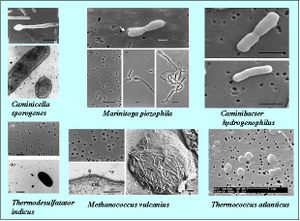Eugena mutabilis: Difference between revisions
| Line 9: | Line 9: | ||
==Description and Significance== | ==Description and Significance== | ||
Euglena is a genus of unicellular flagellate protists. Species of Euglena are typically found in fresh and salt waters. They are often abundant in inland waters, where they may grow in enough numbers to color the surface of ponds and ditches green, for example E. viridis or even red, such as E. sanguinea. | |||
Most species of Euglena have photosynthesizing chloroplasts within the body of the cell, which enable them to feed by autotrophy. However, they can also take nourishment heterotrophically. | Most species of Euglena have photosynthesizing chloroplasts within the body of the cell, which enable them to feed by autotrophy. However, they can also take nourishment heterotrophically. | ||
Revision as of 01:07, 22 July 2013
Classification
Eukaryota/Excavata/Discoba;Euglenozoa; Euglenoidea; Euglenales; Euglenaceae; Euglena mutabilis [Others may be used. Use NCBI link to find]
Euglena mutabilis
Description and Significance
Euglena is a genus of unicellular flagellate protists. Species of Euglena are typically found in fresh and salt waters. They are often abundant in inland waters, where they may grow in enough numbers to color the surface of ponds and ditches green, for example E. viridis or even red, such as E. sanguinea.
Most species of Euglena have photosynthesizing chloroplasts within the body of the cell, which enable them to feed by autotrophy. However, they can also take nourishment heterotrophically. Euglena mutabilis,is a protozoan which has the remarkable ability of being able to survive in the toxic waters of the Berkeley Pit by changing its local environment to something more suitable. By means of photosynthesis, it increases the oxygen level in the water, which causes dissolved metals to oxidize and precipitate out. Furthermore, it pulls iron out of the water and channels it inside of itself, thus, an extremophile. E. Mutabilis, for one, tends to grow in clumps, and these clumps clean up their surroundings enough for other extremophiles to move live in. These organisms would collect the metals within their own cells, and upon dying they would sink to the bottom and drag the metals with them.
Structure, Metabolism, and Life Cycle
Interesting features of its structure; how it gains energy (how it replicates, if virus); what important molecules it produces (if any), does it have an interesting life cycle?
Ecology and Pathogenesis
Natural habitat (soil, water, commensal of humans or animals?)
If relevant, how does this organism cause disease? Human, animal, or plant hosts? Important virulence factors, as well as patient symptoms.
References
[1] EXAMPLE ONLY. REPLACE WITH YOUR REFERENCES. Takai, K., Sugai, A., Itoh, T., and Horikoshi, K. 2000. "Palaeococcus ferrophilus gen. nov., sp. nov., a barophilic, hyperthermophilic archaeon from a deep-sea hydrothermal vent chimney". International Journal of Systematic and Evolutionary Microbiology. 50: 489-500. http://ijs.sgmjournals.org/cgi/reprint/50/2/489
Author
Page authored by _____, student of Mandy Brosnahan, Instructor at the University of Minnesota-Twin Cities, MICB 3301/3303: Biology of Microorganisms.

